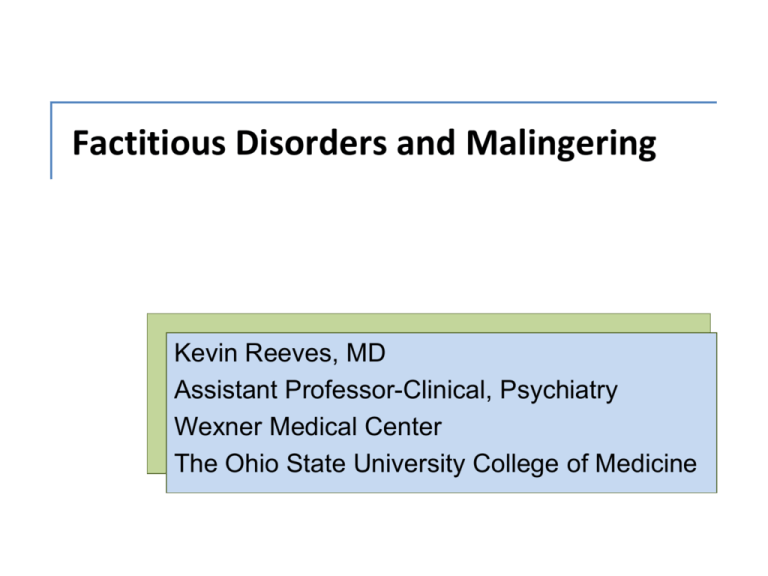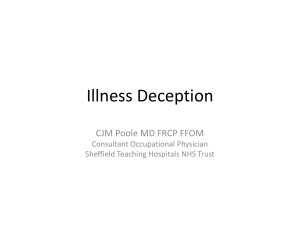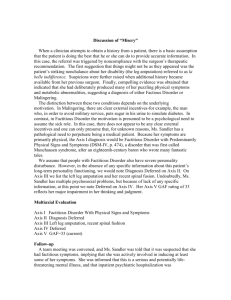Factitious Disorder
advertisement

Factitious Disorders and Malingering Kevin Reeves, MD Assistant Professor-Clinical, Psychiatry Wexner Medical Center The Ohio State University College of Medicine Learning Objectives Approach Differential Diagnosis Significance Diagnostic Criteria Clinical Features Epidemiology Etiology Treatment Course and Prognosis Approach to the Patient Review past records and history, if available Identify your role and establish rapport Identify any accompanying persons Attempt to identify reasons for presentation (referral, emergency) Chief complaint and history of present illness Rigorously clarify vague details and chronology while preserving rapport Physical and Mental Status Examination Obtain collateral information, if possible Consents for Release of Information if the patient is willing Emergency settings may not require a release Confer with colleagues Present plan, targeting their chief complaint, to the patient, with rationale Differential Diagnosis Will depend on the chief complaint Factitious Disorders and Malingering may focus on either physiological or psychological symptoms Differential diagnosis can encompass any body system Significance of the Diagnoses Patients fitting the criteria for the Factitious Disorders can undergo lengthy and expensive workups, with hours of time required for appointments, reviewing results, and performing procedures Patients meeting criteria for Malingering can receive monetary benefits, freedom from responsibilities or legal charges, or otherwise utilize resources which may be appropriate for other patients These patterns can continue, un-interrupted, without proper recognition and management Factitious Disorder DSM-IV-TR Criteria: A. Intentional production or feigning of physical or psychological signs or symptoms. B. The motivation for the behavior is to assume the sick role. C. External incentives for the behavior are absent. Subtypes: With Predominantly/Combined Psychological/Physical Signs and Symptoms Factitious Disorder Not Otherwise Specified Disorders with symptoms that do not meet the criteria for Factitious Disorder. Factitious Disorder by proxy. Clinical Features Physician-patient role disrupted as the physician must “catch” the patient in a falsehood Patients may tamper with or contaminate laboratory samples, wounds or instruments May fabricate physical and/or psychological symptoms within the same encounter The Sick Role Described by a medical sociologist, Parsons in 1951 Being sick confers certain rights and responsibilities on the patient Rights: The patient is not held responsible for being ill, and the patient is exempt from “normal role obligations” Responsibilities: The patient must “seek technically competent help” and must “want to get well” Patients who assume the sick role may benefit from relief of duty toward undesirable responsibilities and obligations, and from sympathy generated in the absence of blame regarding their condition Regarding Primary and Secondary Gain These concepts were originally described by Freud and again by Barsky Definitions in the following slides Appeared, with definitions, as recently as DSM-III-R There, both concepts were defined in the setting of Conversion Disorder Both sources define primary and secondary gain as UNCONSCIOUS processes, i.e. the individual is unaware of the motivation It may be more helpful to think of Factitious Disorders and Malingering as defined in DSM-IV-TR criteria Factitious Disorder patients seek to assume the sick role, but have NO “external incentives” for doing so Patients who malinger are seeking external incentives Economic gain, avoiding legal responsibility or improving physical well being Primary Gain “Reduction in intrapsychic conflict and the partial gratification accomplished by the defensive operation” Defense may be primitive or mature Produces “a symptom of the illness” I.e. conversion, factitious or somatoform symptom Defined most recently in DSM-III-R There related specifically to Conversion Disorder Secondary Gain “Acceptable or legitimate interpersonal advantages that result when one has the symptoms of a disease” May be tangible or intangible rewards: Money, desired working conditions Sympathy and concern from friends or family Popularly used to describe specific financial benefits from intentional symptom production This is inconsistent with the original definition Tertiary Gain Gain realized by a separate party due to the patient’s illness Similar to secondary gain, tertiary may be tangible or intangible As with primary and secondary gain, tertiary gain should be considered to be an unconscious goal Epidemiology Female predominance Young age Psychologically “immature” Many have health care experience, professionally or through interactions with others, and some medical knowledge- self taught or formal Generally, complaints are confined to a single hospital system Patients are more likely to be living within the surrounding community Münchausen’s Syndrome 10% of Factitious Disorders Male predominance Multiple, frequent presentations to hospitals with provocative or fantastic complaints (pseudologia fantasica) Can be life-threatening symptoms Often seek invasive testing or involved treatments Peregrination: Serially visiting hospitals over a wide area Name taken from fantastic account of the exploits of Baron Karl Friedrich Hieronymous von Münchausen, a real life German cavalry officer in the Russian army during the 1700s Treatment Establish rapport with a single provider Prior knowledge of past complaints allows current complaints to be examined in perspective Continuity of care across providers also minimizes unnecessary diagnostic and treatment costs Psychotherapy to address underlying conflicts and stressors Nearly always outpatient level of care Course and Prognosis Outcomes largely dependent on patient engagement in treatment and rapport with providers Range from no improvement with continued dysfunction to remission of symptoms without expected recurrence Malingering No firm criteria given in DSM-IV-TR Strongly suspect if any combination of the following: Medicolegal context of presentation. Marked discrepancy between the person’s claimed stress or disability and the objective findings. Lack of cooperation during diagnostic evaluation and in complying with the prescribed treatment regimen. The presence of Antisocial Personality Disorder. Malingering DSM-IV-TR provides a concept of this diagnosis, stating: “The essential feature of Malingering is the intentional production of false or grossly exaggerated physical or psychological symptoms, motivated by external incentives…” Clinical Features Malingering is a diagnosis based on a specific symptom at a specific time A person may malinger some or all of their symptoms Mental health providers (psychiatrists and psychologists) were not superior to lay persons in detecting malingering Epidemiology One review of 33,000 cases seen by neuropsychologists (usually Ph.D. or Psy.D. level providers who do neuropsychometric testing) reported rates between 8% of medical and psychiatric “cases” and up to 30% of disability or worker’s comp evaluations Management Obtain collateral information from parties who know the patient, if possible Neuropsychological testing can aid in clarifying symptoms and contains an internal metric for poor effort In an emergency situation, prioritize patient safety above suspicion of validity of symptoms Course and Prognosis Patients are intentionally manufacturing symptoms with an intentional goal, and can be difficult to engage or collaborate with This diagnosis is not due to a mental disorder, therefore there is no treatment, per se Patients who have malingered in the past may do so again if they feel the risks and benefits are favorable to them References Hales RB, Yudofsky SC, eds. Essentials of Clinical Psychiatry. 2nd ed. Arlington, VA: American Psychiatric Publishing; 2004. Diagnostic and Statistical Manual of Mental Disorders. 4th ed, Text Revision. Arlington, VA: American Psychiatric Association; 2000. David A. Fishbain. Secondary Gain Concept- Definition, Problems and Its Abuse in Medical Practice. APS Journal. 1994; 3: 264-273. Simon J. Williams. Parsons revisited: from the sick role to…? Health. 2005; 9: 123-144. McCullumsmith CB, Ford CV. Simulated Illness: The Factitious Disorders and Malingering. Psychiatr Clin N Am. 2011; 34: 621-641. Thank you Do not hesitate to contact me. Email with questions/comments: Kevin.Reeves@osumc.edu 28 Survey We would appreciate your feedback on this module. Click on the button below to complete a brief survey. Your responses and comments will be shared with the module’s author, the LSI EdTech team, and LSI curriculum leaders. We will use your feedback to improve future versions of the module. The survey is both optional and anonymous and should take less than 5 minutes to complete. Survey





![Illness deception [revised version]](http://s3.studylib.net/store/data/008285672_1-42f007d9a78e6271ab46672f4d7f9064-300x300.png)
